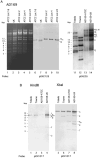Reassessing the organization of the UL42-UL43 region of the human cytomegalovirus strain AD169 genome
- PMID: 9426456
- PMCID: PMC4283199
- DOI: 10.1006/viro.1997.8875
Reassessing the organization of the UL42-UL43 region of the human cytomegalovirus strain AD169 genome
Abstract
A polymorphism in the UL42-UL43 region of the human cytomegalovirus genome has been characterized by nucleotide sequence analysis, revealing a 929-bp insertion following nt 54,612 relative to the published strain AD169-UK genome sequence (M.S. Chee et al., 1990, Curr. Top. Microbiol Immunol. 154, 125-170). Although AD169-UK exhibited polymorphism in this genomic region, other CMV strains (Towne, Toledo, and AD169-ATCC) carried only the newly characterized longer form. The additional sequence altered the assignment of UL42 and UL43 open reading frames. UL42 decreased in size from 157 to 125 codons, retaining 76 of the previously reported carboxyl terminal codons, and UL43 increased in size from 187 to 423 codons, retaining 185 of the previously reported amino terminal codons. This additional sequence makes UL43 a more conserved betaherpesvirus US22 family member. Only AD169-UK exhibited restriction fragment length polymorphism in this region, suggesting that a deletion occurred during the propagation of this strain in cell culture. The additional sequence should be considered a bona fide part of the cytomegalovirus genome and the AD169 genome size should be corrected to 230,283 bp.
Figures



Similar articles
-
The published DNA sequence of human cytomegalovirus strain AD169 lacks 929 base pairs affecting genes UL42 and UL43.J Virol. 1997 Dec;71(12):9833-6. doi: 10.1128/JVI.71.12.9833-9836.1997. J Virol. 1997. PMID: 9371656 Free PMC article.
-
Human cytomegalovirus clinical isolates carry at least 19 genes not found in laboratory strains.J Virol. 1996 Jan;70(1):78-83. doi: 10.1128/JVI.70.1.78-83.1996. J Virol. 1996. PMID: 8523595 Free PMC article.
-
Construction of a self-excisable bacterial artificial chromosome containing the human cytomegalovirus genome and mutagenesis of the diploid TRL/IRL13 gene.J Virol. 2002 Mar;76(5):2316-28. doi: 10.1128/jvi.76.5.2316-2328.2002. J Virol. 2002. PMID: 11836410 Free PMC article.
-
A review of genetic differences between limited and extensively passaged human cytomegalovirus strains.Rev Med Virol. 2001 May-Jun;11(3):191-200. doi: 10.1002/rmv.315. Rev Med Virol. 2001. PMID: 11376481 Review.
-
Analysis of the protein-coding content of the sequence of human cytomegalovirus strain AD169.Curr Top Microbiol Immunol. 1990;154:125-69. doi: 10.1007/978-3-642-74980-3_6. Curr Top Microbiol Immunol. 1990. PMID: 2161319 Review. No abstract available.
Cited by
-
Murine cytomegalovirus m41 open reading frame encodes a Golgi-localized antiapoptotic protein.J Virol. 2003 Nov;77(21):11633-43. doi: 10.1128/jvi.77.21.11633-11643.2003. J Virol. 2003. PMID: 14557649 Free PMC article.
-
High-throughput sequence analysis of variants of human cytomegalovirus strains Towne and AD169.J Gen Virol. 2009 Oct;90(Pt 10):2375-2380. doi: 10.1099/vir.0.013250-0. Epub 2009 Jun 24. J Gen Virol. 2009. PMID: 19553388 Free PMC article.
-
In vitro and in vivo characterization of a murine cytomegalovirus with a transposon insertional mutation at open reading frame M43.J Virol. 2000 Oct;74(20):9488-97. doi: 10.1128/jvi.74.20.9488-9497.2000. J Virol. 2000. PMID: 11000218 Free PMC article.
-
DNA microarrays of the complex human cytomegalovirus genome: profiling kinetic class with drug sensitivity of viral gene expression.J Virol. 1999 Jul;73(7):5757-66. doi: 10.1128/JVI.73.7.5757-5766.1999. J Virol. 1999. PMID: 10364327 Free PMC article.
-
Human cytomegalovirus pUS24 is a virion protein that functions very early in the replication cycle.J Virol. 2006 Sep;80(17):8371-8. doi: 10.1128/JVI.00399-06. J Virol. 2006. PMID: 16912288 Free PMC article.
References
-
- Alford CA, Britt WJ. Cytomegalovirus. In: Fields BN, Knipe DM, Howley PM, editors. Fields Virology. Lippincott-Raven; New York: 1995. pp. 2493–2534.
-
- Altschul SF, Gish W, Miller W, Myers EW, Lipman DJ. Basic local alignment search tool. J Mol Biol. 1990;215:403–410. - PubMed
-
- Boshart M, Weber F, Jahn G, Dorsch-Hasler K, Fleckenstein B, Schaffner W. A very strong enhancer is located upstream of an immediate early gene of human cytomegalovirus. Cell. 1985;41:521–530. - PubMed
-
- Brown JM, Kaneshima H, Mocarski ES. Dramatic interstrain differences in the replication of human cytomegalovirus in SCID-hu mice. J Infect Dis. 1995;171:1599–1603. - PubMed
-
- Cardin RD, Boname JM, Abenes GB, Jennings SA, Mocarski ES. Reactivation of murine cytomegalovirus from latency. In: Plotkin S, Michelson S, editors. Multidisciplinary Approaches to Understanding Cytomegalovirus Disease. Elsevier; Amsterdam: 1993. pp. 101–110.
Publication types
MeSH terms
Associated data
- Actions
Grants and funding
LinkOut - more resources
Full Text Sources
Research Materials

